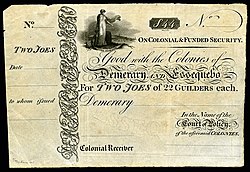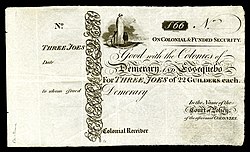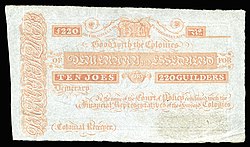Banknotes of Demerary and Essequibo
Banknotes of Demerara and Essequibo, issued from 1809[1] through 1839[2] were dual-denominated in Guilders and Joes, a term used by the British colonists to refer to the Portuguese gold Johannes coin[3] and the notes that eventually replaced them.[4] Despite roughly 30 years of use, the only Joes known to exist are unissued remainders from the 1830s.[5]
History
editDating back to at least 1798, the main unit of monetary exchange in the colonies of Demerara and Essequibo was the Portuguese gold Johannes coin[6] which were valued at 22 Dutch guilders.[2] Exchange rates in the United States in 1797 valued the Portuguese Johannes at $16 (the Spanish doubloon at $14.93, and the English silver shilling at $0.22).[7] Due to clipping and boring (replaced with brass or copper)[4] these coins (colloquially referred to as a Joe)[4] began to lose their intrinsic value. An initial attempt was made to counterstamp or chop mark valid coins.[6] Eventually (1809) the coins were recalled by the authorities and paper currency, denominated in both Guilders and Joes were issued.[2]
Issuance
editThe new paper issue of 1809 introduced 50,000 Joes equivalent to 1,100,000 guilders.[8] This was followed by an additional 25,807 Joes in 1815–16,[8] and 24,193 more in 1824 for a total circulation of just under 100,000 Joes.[8] Deemed to be a legal tender,[8][2] the notes were partially backed by securities in London,[2] though their ability to be redeemed for gold was questionable.[6]
By 1837, records indicate that 99,989 Joes had been issued in the following denominations: 1 Joe (13,258 notes), 2 Joes (8,189), 3 Joes (4,201), 5 Joes (3,150), 10 Joes (1,700), and 20 Joes (1,250).[9] By 1839, there had been reference to a half-Joe.[10]
Currently known specimen
editThe Standard Catalog of World Paper Money lists only the unissued remainders of the 1830s. The two issues are distinguished by several design features including an ornate D-E in the upper center (first issue) or a woman with an anchor in the upper left (second issue).[5] In addition, the wording of the denomination differs between the series. The first issue lists two denominations: 1 Joe or 22 Guilders and 10 Joes or 220 Guilders; the second issue lists four denominations: 1 Joe of 22 Guilders, 2 Joes of 22 Guilders each, 3 Joes of 22 Guilders each, and 10 Joes of 22 Guilders each.[5] The illustrated 20 Joe note is a recent discovery (for the 1830s issue) in the National Numismatic Collection.
References
edit- ^ Hazlitt, William Carew (1896). The Coin Collector. G. Redway. p. 241.
- ^ a b c d e The New Local Guide of British Guiana: Containing Historical Sketch, Chronological List, and the Ordinances in Daily Use, Up to 31st December, 1862. Royal Gazette Office. 1863. p. 9.
- ^ Halliday, Sir Andrew (1837). The West Indies: The Natural and Physical History of the Windward and Leeward Colonies; with Some Account of the Moral, Social, and Political Condition of Their Inhabitants, Immediately Before and After the Abolition of Negro Slavery. J. W. Parker. p. 192.
- ^ a b c Dalton, Henry G. (1855). The History of British Guiana: Comprising a General Description of the Colony ; a Narrative of Some of the Principal Events from the Earliest Period of Its Discovery to the Present Time ; Together with an Account of Its Climate, Geology, Staple Products, and Natural History. Longman, Brown, Green, and Longmans. pp. 290–292, 360.
- ^ a b c Cuhaj, George S. (2013-12-30). Standard Catalog of World Paper Money, Specialized Issues. Krause Publications. p. 153. ISBN 978-1-4402-3883-3.
- ^ a b c Chalmers, Robert (1972). A history of currency. Рипол Классик. pp. 94, 135. ISBN 978-5-87888-302-3.
- ^ Bates, Christopher G. (2015-04-08). The Early Republic and Antebellum America: An Encyclopedia of Social, Political, Cultural, and Economic History. Routledge. p. 674. ISBN 978-1-317-45740-4.
- ^ a b c d Dalton, Henry G. (1855). The History of British Guiana: Comprising a General Description of the Colony ; a Narrative of Some of the Principal Events from the Earliest Period of Its Discovery to the Present Time ; Together with an Account of Its Climate, Geology, Staple Products, and Natural History. Longman, Brown, Green, and Longmans. pp. 290–292, 360.
- ^ Martin, Robert Montgomery (1839). Statistics of the Colonies of the British Empire ...: From the Official Records of the Colonial Office. W.H. Allen and Company. p. 134.
- ^ Guiana, British (1870). The Laws of British Guiana: Chronologically Arranged from the Year 1580 to [1880]. L. M'Dermott. p. 242.
Source
edit- Schomburgk, Robert H. (1840). A Description of British Guiana, Geographical and Statistical…. Simpkin, Marshall, and Co.




